A few hours ago these crocuses were under cover of snow. The sun is warm but the wind is making for a brisk and cold day. The sun has been out long enough between fast-moving clouds to warm up the ground and melt the snow.

WildeHerb is a collection of wild herb and wildflower sightings.
On Monday we had to check the calendar to verify that we were still in Winter as the temperature soared to 75 degrees. This morning is quite another story as gusty winds are whipping the snow around sideways. I wonder if the tulips by the house will survive the last throes of Winter.
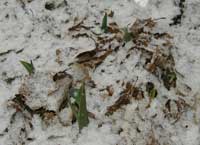
The tulips adjacent to the house may have been faked out by receiving extra heat, but certainly not the little purple crocuses that are 50 feet or so across the drive. They must be own their own cycle.
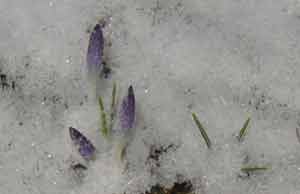
A curiosity — Are plants more likely to respond to the warming trend in Spring or to the lengthening days? Scientists may not even know the real answers because increasing temperatures and longer days are so closely intertwined. The "Ides of March" are upon us!
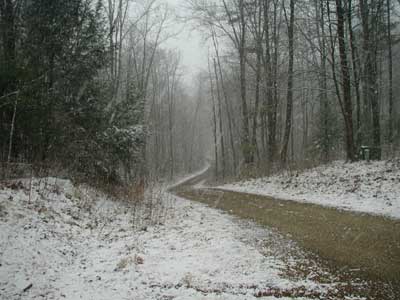
I’ll let the snow squall pass before I venture out today. Even as I write this the clouds have cleared to reveal a blue sky, and yet, stray snowflakes are being whisked around by the winds.
The tiny white, four-petaled flowers of the small-leaved bitter cress were in full bloom yesterday. A low-growing plant, this bitter cress is indeed inconspicuous as are its eighth-inch flowers.
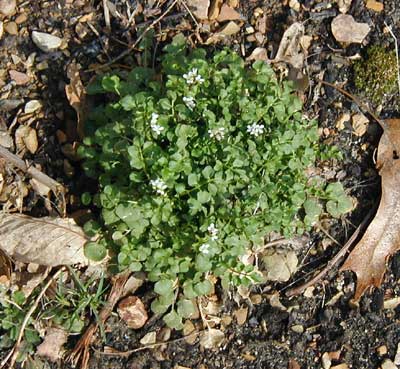
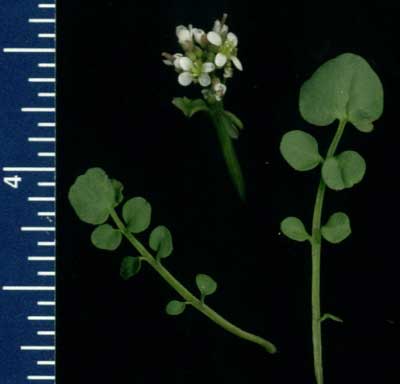
Describing the leaves is more difficult. What appears to be many pairs of opposite small leaves on a stem is actually a single leaf that is deeply lobed or divided. The leaves alternate up the main stem.
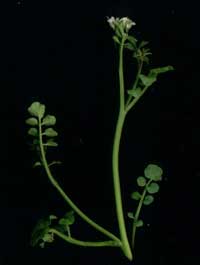
Relatives of the small-flowered bitter cress are said to be good in salads, but this Cardamine species basically tasted like grass.
This past weekend saw a lot of bird activity. Canada geese resumed their northward flights in giant V-formations. The sound of them coaxing each other further on is delightful! Rarely do we get to hear such natural communication by wild creatures as we sit on the back porch.
Other birds were seen and heard in action, especially the bluebirds calling for mates and taking turns standing on the bluebird nesting box. There have been a small group of bluebirds appearing here and there for a few weeks now. Here’s another true sign of Spring, a few robins searching the ground for a meal.
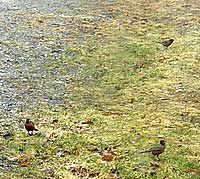
The first robin of the season was spotted last Thursday. Since then we have been having quite warm, but windy and rainy weather. The last few days have reached into the 60s and the nights very mild in the 40s and 50s. Forecasts call for more blustery skies early in the week, so nature walks for flower pictures are on hold until the skies are partially clear and the wind is a bit more calm.
Taking a nature walk, hiking your favorite trail, driving to work, walking on campus, or taking your child to the bus stop are all opportunities to see what is blooming in your neighborhood. As you go about your daily business do take time to stop, look and listen! Chances are that you will see something new, or something that you never noticed before.
Even though I have walked around my wooded property many, many times, I still notice new things as the seasons change. Yesterday, I took notice of a small hemlock tree that I had never really observed before. The tree was small, for a hemlock, only about 12 feet high. It was being crowded by some witch hazel and white pine trees. Since the hemlock was not very close to any large, mature trees, I decided to give it a little more space by cutting down the white pines next to it.
The witch hazels I left in place as they would not grow much taller for they are understory trees in our eastern woodlands. However, I have made a note to myself to check on their growth this year to judge if they may be crowding the little hemlock. After all, the eastern hemlock tree, Tsuga canadensis (L.) Carr., is the state tree of Pennsylvania. I think it fitting to protect and encourage the growth of a beautiful specimen of this stately tree.
Looking out the kitchen window on the ice-covered trees as I made coffee, I thought that I must get some pictures of the thousand lights blinking back at me. The early morning sun reflecting in each drop of frozen water made a starry scene of blue and white bright twinkling lights on the frozen vegetation. Will my little red azalea ever come back to life?
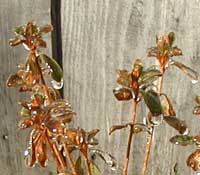
Surely the white pine boughs will spring back up when the ice melts away.
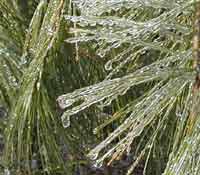
Well, if anything is true of late Winter it is that the weather is quite unpredictable. Last night an inch of light, fluffy, very dry snow covered everything. It was the kind of snow that squeaks when you walk on it. About mid-day most of the snow was gone, except for the shady areas.
So, Spring is not quite here yet and Mother Nature is making sure we are paying her attention. I captured a few snowy pictures, but the one I like the best is this image of last year’s sumac with a top coating of snow.
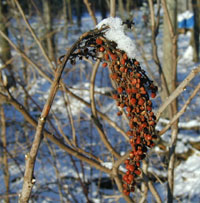
The raspberry vines that I said were already sprouting yesterday, are not vines at all. I was mistaken for it appears to be a sassafras stem that has started to sprout.
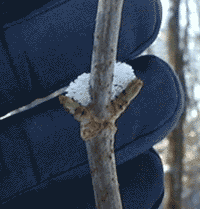
Time will tell for sure and I will update this when the leaves finally show themselves.
Two days ago I spotted my first signs of Spring. I figured the lilies that poked through the ground a week ago next to the house didn’t really count, but when I saw the raspberry buds pushing out on Saturday I knew that the mild Winter was probably going to trade off with an early Spring. I could not see a flock of Canada Geese flying North, but I certainly did hear them as they coached each other to their frozen destination. A cold front was coming in later in the day and we were still on the warm side of it when the geese flew overhead. Wind blew hard that night the cold front came in and, again, we lost our electricity for a few hours until the winds died back.